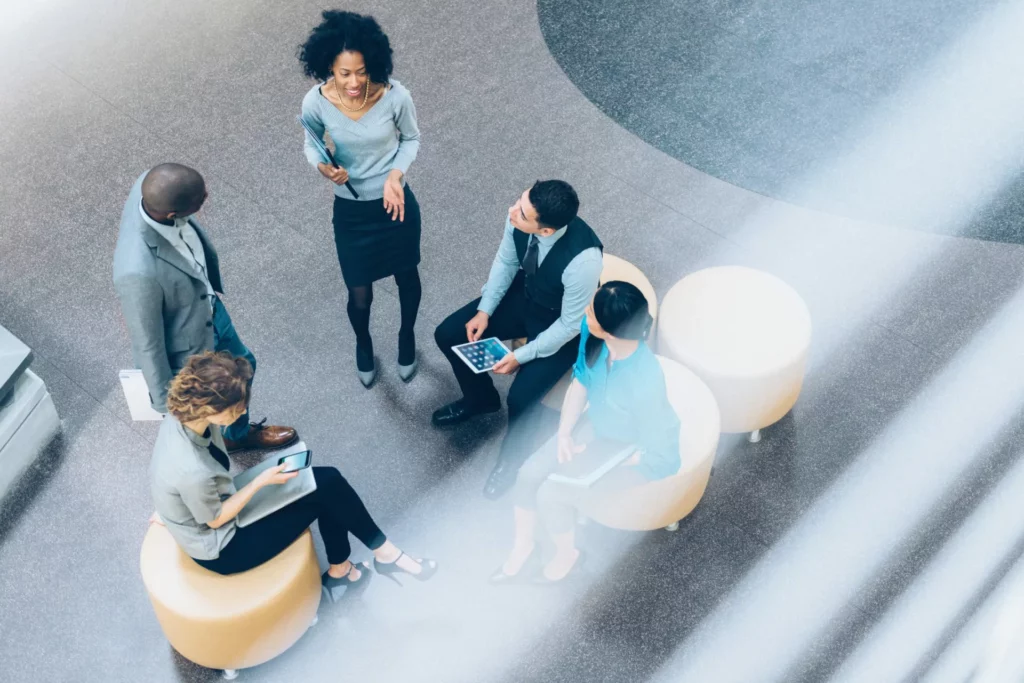What Is Tacit Knowledge—And Why It’s Your Company’s Most Valuable Asset

Tacit knowledge is an organization’s most valuable, yet hardest-to-capture asset. Often described as “know-how,” tacit knowledge is the unspoken expertise residing within your employees’ minds. It encompasses the practical skills, intuition, and personal experience that drive efficiency but are too complex to be written down.
Learn the full tacit knowledge definition, see key tacit knowledge examples, discover how to overcome the challenge of sharing this indispensable intellectual property, and find out its role in achieving true Enterprise Intelligence.
What is Tacit Knowledge?
Tacit knowledge refers to the subjective and personal insights one gains through experience and intuition, which are difficult to document, transfer, and articulate.
If someone asked you to share this knowledge, it would be hard to put into words—it’s simply through your years of practice that you’ve acquired this information.
Tacit knowledge is sometimes referred to as “tribal knowledge,” as it spreads throughout an organization (or a group within an organization) without being documented. Instead, it’s shared from person to person. In fact, you may not even realize you have that knowledge until someone asks you about it.
For example, someone asked a veteran sales representative how he knows when a prospect is almost ready to buy. Through years of experience, the rep can clearly see the signals—spoken and unspoken—that a potential customer is ready to take the next step. There’s probably no formal documentation of those signals; instead, it’s something you learn over time or with the help of more experienced employees.
Summary: Characteristics that Define Tacit Knowledge
| Personal and contextual: | Tacit knowledge is inherently tied to the individual’s experiences and the specific context in which they operate. This makes it unique to each employee and challenging to transfer. |
| Difficult to formalize: | Unlike explicit knowledge, which can be documented in manuals or databases, tacit knowledge often resides in the minds of employees and is not easily captured in written form. |
| Learned through experience: | Tacit knowledge is acquired through hands-on experience, observation, and practice rather than formal education or training. |
Real-World Examples of Tacit Knowledge
Studies show that a significant majority of an organization’s total knowledge is embedded and synthesized in the minds of its employees, making the capture and transfer of this knowledge a critical business objective. Understanding the meaning and applications is essential to this effort.
The following examples of tacit knowledge demonstrate how this deeply embedded, personal experience translates into superior performance across various business functions.
- Sales: A senior account executive’s ability to read a client’s body language and know when to push for the close or when to back off. They can’t write a step-by-step guide for this, as it’s an instinct honed over years of interactions.
- Customer support: A seasoned support agent’s knack for de-escalating a tense customer situation with just the right tone of voice and a reassuring phrase, a skill that goes beyond the standard script.
- Engineering & manufacturing: A skilled technician’s deep understanding of a machine’s quirks and sounds enables them to diagnose potential failures long before they occur.
- Leadership: An effective manager’s intuition for team dynamics, knowing how to motivate different individuals and foster a collaborative environment without a formal playbook.
- Marketing: A creative director’s gut feeling about which visual concept will resonate with a target audience, a decision often based on years of observing trends and consumer behavior.
From these examples, it is clear that the highest levels of performance rely on more than just documented procedures. The critical challenge, then, is bridging the gap between an individual’s unique skill and the scalable knowledge of a company. This is where the commitment to Enterprise Intelligence is essential. It’s the strategic process of taking these isolated, high-value instances of tacit knowledge (e.g., the feel of a machine, the intuition for a client, the gut feeling about a design) and transforming them into scalable, organizational assets.
Operationalize Tacit Knowledge
Transform personal expertise into Enterprise Intelligence embedded in your systems.
Start Here
Advantages of Utilizing Tacit Knowledge
When understanding what tacit knowledge is all about, it’s easy to associate it with the driving force that allows your employees to do their jobs well. It allows your employees to perform their roles and exceed expectations. Research suggests that managing tacit knowledge offers concrete benefits, including a 20-35% improvement in time-to-productivity for new hires and a decrease in knowledge loss during employee turnover.
When documented and well-organized in the workplace, tacit information offers the following benefits:

1. Accelerated learning and adaptation
When tacit knowledge is shared among team members, it significantly reduces the learning curve for new employees. A culture of tacit intelligence sharing allows them to gain valuable insights, intuition, and context by observing and interacting with more experienced colleagues. This instant transfer of practical, on-the-job wisdom helps new employees master their responsibilities much faster. Plus, they can better adapt to the company’s unique culture and workflows.
2. Increased production
Without a way to document and share tacit knowledge, it can take employees years to gain that know-how. However, when all your employees have access to your organization’s tacit knowledge, along with all types of knowledge, they can get up to speed more quickly, without the years of trial and error.
There is no need to reinvent the wheel as employees gain valuable shortcuts and are quicker to become self-sufficient and expertly address customer issues. Ultimately, this boosts the collective productivity of your organization.
3. Competitive advantage
The ability to communicate tacit information allows your entire company to work at a higher level. When all employees understand the true definition of tacit knowledge and have access to the expertise of your most experienced employees, they will be better equipped to serve your customers. And when your customers come to realize that they can count on your company, they will come to trust you above any of your competitors or peers.
4. Healthy workplace culture
When employees share tacit knowledge, they learn from each other’s successes and failures. This knowledge-sharing culture fosters a stronger sense of team cohesion, as individuals feel valued for their unique contributions and are empowered to learn directly from their peers’ successes and failures.
For example, a senior developer sharing their rules of thumb for debugging a tricky piece of code in a casual team chat not only solves the immediate problem but also builds a sense of community and shared purpose, making the entire team more resilient.
5. Innovation and creativity
Tacit knowledge fosters an environment where employees feel empowered to share ideas and collaborate. This exchange of insights can lead to innovative solutions and creative approaches to challenges. A systematic literature review analyzing studies from 2019 to 2024 revealed that tacit knowledge sharing significantly boosts employee innovation through improved creativity and problem-solving capabilities.
6. Risk mitigation
When a key employee retires or leaves the company, their tacit knowledge often leaves with them. This brain drain can lead to a significant loss of productivity and institutional memory, making the organization vulnerable to repeating past mistakes.
On the other hand, if you create systems to identify, capture, and share this vital expertise, organizations can transfer this knowledge from the individual to the collective, significantly reducing the risk of experiencing a decline in operational efficiency. Moreover, if you transform tacit knowledge into Enterprise Intelligence, you move from knowledge preservation to insights mobilization, strengthening your collective knowledge assets.
7. Organizational resilience
In a crisis or an unpredictable situation, a team’s ability to rely on collective experience and intuition is often the difference between success and failure. Tacit knowledge allows for agile, on-the-spot decision-making.
For example, during a sudden supply chain disruption, a seasoned procurement team member doesn’t need a new manual. Their tacit knowledge, gained from years of dealing with vendor relationships and market volatility, instinctively guides them to alternative, undocumented suppliers they trust. This allows the company to pivot and minimize operational downtime immediately.
How to Unlock Tacit Knowledge for Enterprise Intelligence
Achieving Enterprise Intelligence requires a conscious shift away from relying on informal, non-scalable, and tribal knowledge toward actively operationalizing the valuable insights embedded in employee experiences, conversations, and workflows. This process begins by recognizing that tacit knowledge is not a documentation problem, but a cultural and technical challenge of capturing contextualized expertise.
Enterprise Intelligence accomplishes this not by forcing experts to write tedious manuals, but by making knowledge management and sharing frictionless. The goal is to elevate individual expertise into a scalable, actionable corporate asset that drives innovation and competitive advantage, connecting the seemingly invisible knowledge held by individuals across the entire enterprise.
Here are the key steps to operationalize tacit knowledge for Enterprise Intelligence:
- Integrate tacit knowledge capture into workflow: Utilize AI-enabled tools that integrate directly into collaboration platforms (like Slack or Teams) to automatically index and make searchable key conversations, decisions, and lessons learned.
- Deploy contextual Q&A systems: Implement intelligent Q&A or internal search engines that connect a new question directly to the person who has the expertise, or to a relevant snippet of a previous conversation or recorded meeting, effectively bypassing the need for formal documentation.
- Utilize skill and expertise locators: Employ platforms that allow employees to tag their specific expertise based on their contributions and project involvement, making it easy for others to find the “go-to” person for a complex, tacit-driven issue.
The ultimate value of connecting all tacit knowledge for a wider Enterprise Intelligence is the creation of a single, unified source of truth that powers the entire organization. When tacit insights from all departments are integrated, the company gains a holistic, 360-degree view of its operations and customer base. This interconnected knowledge base ensures that every employee, regardless of tenure or location, can access the collective wisdom of the enterprise.
How to Incorporate Tacit Knowledge Sharing Into Your Culture
To realize these benefits, however, you must encourage the sharing of tacit knowledge within your organization. This begins with clearly communicating the value of collaboration—but it requires more than simply telling employees that it’s important; you must also weave it into the way you do business.
For example, encourage collaboration by hosting more team activities and assigning team projects. Pay particular attention to pairing veteran employees with less experienced workers. By working closely together, your employees will come to realize how much knowledge they can gain from one another. Eventually, this will lead to an increase in organic knowledge sharing.

1. Build psychological safety
Organizational leaders must foster an environment of trust and reciprocity where employees are rewarded not only for possessing expertise but also for sharing it. This means encouraging a learn-by-doing culture where discussing mistakes and unconventional solutions is met with analysis, not criticism, thereby normalizing productive failure.
Proactively celebrate the act of mentorship, and establish safe channels (like anonymous Q&A) where employees can ask basic or context-specific questions without fear of judgment. Doing so ensures that employees are motivated to contribute their unique, personal insights rather than hoarding them for job security.
2. Implement experiential learning mechanisms
To successfully implement experiential learning mechanisms for sharing tacit knowledge, organizations must prioritize structured, social interactions over passive transfer. Establish dedicated programs, such as structured mentorships or apprenticeships, that deliberately pair experts with novices. Understanding the meaning of tacit knowledge also helps reinforce this approach.
Additionally, establish informal, cross-functional groups that meet regularly to solve real, novel business problems, also known as Communities of Practice (CoPs). These collaborative sessions naturally force the externalization and transfer of unwritten expertise and intuition as team members negotiate and share their experience-based insights.
3. Increase sharing opportunities
You can also create more focused and structured opportunities for knowledge sharing, which align with the core principles of Enterprise Intelligence. Whether you include two employees or every member of the company, you can use these opportunities to facilitate the sharing of tacit knowledge. The opportunities could include:
- One-on-one meetings
- Group discussions
- Roundtables
- Town hall meetings
Set each meeting with the intent of sharing tacit knowledge. This could mean asking two employees to interview each other, having a new hire shadow a 10-year veteran, or curating focused questions for a panel of the most experienced workers from a particular department. Encourage everyone involved to view these meetings as an opportunity to gain insight and know-how.
4. Promote immersive documentation
To effectively capture tacit knowledge, organizations must be creative. Company leaders must push themselves to find ways to make knowledge documentation less dry and incorporate more color around employees’ experiences and expertise. In other words, it all comes down to the art of storytelling.
While you can’t codify all tacit knowledge, you can use specific techniques to draw out the underlying principles and convert them into a more accessible, shareable form.
- Storytelling: Encourage experts to narrate the story of a successful project, a crisis averted, or a complex decision. Stories naturally embed the context, emotion, and intuition (tacit information) that a simple procedure omits.
- Expert interviews and capture sessions: Conduct structured, recorded interviews with high-performing employees. The goal isn’t a final document, but a searchable transcript or video that reveals the expert’s thought process, rules of thumb, and decision-making logic.
- Visual mapping: Use methods like mind mapping or process diagrams with the expert to visually map out their workflow, including the unwritten decision points and contingency plans they instinctively follow.
Consider asking employees to document personal experiences. Instead of a one-sentence answer of why a sales representative lost a sale, for instance, they should provide an in-depth explanation of exactly what went right or wrong, so that other representatives can learn from that experience. Those stories will allow other employees to connect on a personal level and transform dry, straightforward information into rich, memorable, immersive content.
Frequently Asked Questions
How do you identify tacit knowledge?
You identify tacit knowledge by observing expertise in action and focusing on situations where documented procedures fall short. This is typically done through behavioral observation and process narration techniques, where experts are asked to ‘think aloud’ and explain their instincts, rules of thumb, and judgments during the decision-making process.
How do employees gain tacit knowledge?
Employees primarily acquire tacit knowledge through experiential learning, such as repeatedly practicing a skill, engaging in trial and error, and reflecting on the outcomes. It’s often absorbed through socialization methods, which involve direct observation of, and interaction with, experienced peers, mentors, or experts in real-world scenarios.
What are the three types of tacit knowledge?
The three main categories of tacit knowledge are cognitive, technical, and social. Cognitive tacit knowledge involves an individual’s mental models, intuition, and beliefs that shape their approach to problem-solving. Technical tacit knowledge refers to the hands-on, uncodifiable skills and dexterity required to perform a task, such as those found in craftsmanship. Social tacit knowledge covers the interpersonal skills and unwritten cultural norms necessary for effective communication and collaboration within a group.
How do you measure tacit knowledge?
Measuring tacit knowledge is challenging because it’s deeply ingrained and hard to articulate, so organizations often use indirect methods like structured interviews, performance reviews, and behavioral assessments to observe its application in practical scenarios. These approaches focus on evaluating the outcomes and demonstrations of skill rather than trying to explicitly capture the underlying, uncodified know-how itself.
Supercharge Tacit Knowledge for Enterprise Intelligence
Maximize your organization’s collective wisdom and accelerate its journey toward Enterprise Intelligence. Don’t let crucial tacit knowledge remain locked in silos or walk out the door when experts leave. Understanding the tacit definition is only the first step toward transforming individual know-how into a scalable, operational asset.
Leverage modern AI-driven tools, such as those found in the Bloomfire platform, to automatically capture and connect key insights from daily conversations, workflows, and meetings, reducing the manual burden on your top talent.
Unlock True Enterprise Intelligence
See how operationalizing unspoken expertise drives superior business performance.
Request a Consultation

How Knowledge Management Enhances the Decision-Making Process of Organizations

How You Can Use Knowledge Management to Finally Achieve Operational Excellence

Knowledge Management History: Why Businesses Took 50 Years to Adopt It

Estimate the Value of Your Knowledge Assets
Use this calculator to see how enterprise intelligence can impact your bottom line. Choose areas of focus, and see tailored calculations that will give you a tangible ROI.

Take a self guided Tour
See Bloomfire in action across several potential configurations. Imagine the potential of your team when they stop searching and start finding critical knowledge.